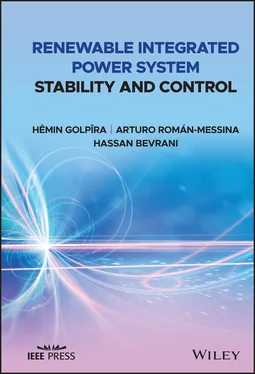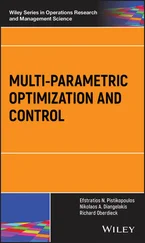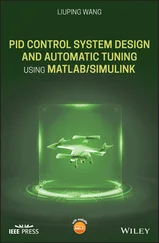1 Cover
2 Series Page IEEE Press 445 Hoes Lane Piscataway, NJ 08854 IEEE Press Editorial Board Ekram Hossain, Editor in Chief Jón Atli Benediktsson David Alan Grier Elya B. Joffe Xiaoou Li Peter Lian Andreas Molisch Saeid Nahavandi Jeffrey Reed Diomidis Spinellis Sarah Spurgeon Ahmet Murat Tekalp
3 Title Page
4 Copyright Page
5 Dedication Page
6 Preface
7 Acknowledgments
8 Nomenclature
9 List of Abbreviations and Acronyms
10 1 Introduction 1.1 Power System Stability and Control 1.2 Current State of Power System Stability and Control 1.3 Data‐Driven Wide‐Area Power System Monitoring and Control 1.4 Dynamics Modeling and Parameters Estimation 1.5 Summary References
11 2 MG Penetrated Power Grid Modeling 2.1 Introduction 2.2 Basic Concepts 2.3 Power Grid Modeling 2.4 MG Equivalent Model 2.5 Summary References
12 3 Stability Assessment of Power Grids with High Microgrid Penetration 3.1 Introduction 3.2 Frequency Stability Assessment 3.3 Maximum Penetration Level: Frequency Stability 3.4 Small‐Signal Stability Assessment 3.5 Maximum Penetration Level: Small‐Signal Stability 3.6 Voltage‐Based Realization of the MG‐Integrated Power Grid 3.7 Summary References
13 4 Advanced Virtual Inertia Control and Optimal Placement 4.1 Introduction 4.2 Virtual Synchronous Generator 4.3 Dispatchable Inertia Placement 4.4 Summary References
14 5 Wide‐Area Voltage Monitoring in High‐Renewable Integrated Power Systems 5.1 Introduction 5.2 Voltage Control Areas: A Background 5.3 Data‐driven Approaches 5.4 Theoretical Framework 5.5 Case Study 5.6 Summary References
15 6 Advanced Control Synthesis 6.1 Introduction 6.2 Frequency Dynamics Enhancement 6.3 Small Signal Stability Enhancement 6.4 Summary References
16 7 Small‐Signal and Transient Stability Assessment Using Data‐Driven Approaches 7.1 Background and Motivation 7.2 Modal Characterization Using Data‐Driven Approaches 7.3 Studies of a Small‐Scale Power System Model 7.4 Large‐Scale System Study 7.5 Analysis Results and Discussion References
17 8 Solar and Wind Integration Case Studies 8.1 General Context and Motivation 8.2 Study System 8.3 Wind Power Integration in the South Systems 8.4 Impact of Increased Wind Penetration on the System Performance 8.5 Frequency Response 8.6 Effect of Voltage Control on System Dynamic Performance 8.7 Summary References
18 Index
19 End User License Agreement
1 Chapter 2Table 2.1 Comparison of two slowest modes for original model and equivalent m...Table 2.2 Comparison of first swing amplitudes.Table 2.3 Sensitivity of virtual reactances to voltage variations.Table 2.4 Comparison of modal analysis results.Table 2.5 Comparison of frequency dynamics using the washout filter and propo...Table 2.6 Computational burden of different bus frequency estimators.Table 2.7 Computational burden of different bus frequency estimators.Table 2.8 Uncertainty analysis of the equivalencing.
2 Chapter 3Table 3.1 Frequency dynamics error for NYNE test system under 5.6% penetratio...Table 3.2 Frequency dynamics error for NYNE test system under 8% penetration ...Table 3.3 Maximum phase angle difference in deg.Table 3.4 Minimum permissible rotational inertia in response to tripping G 14.Table 3.5 Maximum penetration level for 16‐machine test system.Table 3.6 Maximum inertia reduction for 50‐machine test system.Table 3.7 Critical modes of the base system.Table 3.8 Critical mode detrimentally affected by high MGs.Table 3.9 Eigenvalue sensitivity analysis in the 20% MGs penetration.
3 Chapter 4Table 4.1 Economical parameters related to the optimization problem [42, 43].Table 4.2 Technical parameters related to the optimization problem [41].Table 4.3 Optimization results in three‐area system.Table 4.4 Modal analysis of the systems with virtual inertia.Table 4.5 Optimization results in two‐area system.Table 4.6 Frequency indicators of two‐area system before and after the applic...Table 4.7 Transients stability assessment.Table 4.8 Optimization results in NYNE test system.Table 4.9 Optimization results in New England system.Table 4.10 Sensitivity analysis.Table 4.11 Critical modes of the base system.
4 Chapter 5Table 5.1 The Markov clustering algorithm.Table 5.2 Short‐circuit levels (MVA) for the 400‐kV transmission network.Table 5.3 The largest attenuation values α ijcomputed using (5.4). Base o...Table 5.4 Candidate pilot buses selected using the information from electrica...Table 5.5 Bus pilot nodes selected from the identification of reactive power ...Table 5.6 Selected system measurements.Table 5.7 Contingency scenarios selected for analysis.Table 5.8 Clustering of bus voltage signals using c ‐means.Table 5.9 Top 10 (unnormalized) entries of the voltage‐based DMD eigenvector ...Table 5.10 The five largest interaction coefficients m ijcomputed using (5.5) ...
5 Chapter 6Table 6.1 Comparison of maximum penetration level for NYNE test system with a...Table 6.2 Required ESS capacity to enable high penetration of MG.
6 Chapter 7Table 7.1 Hankel‐based Prony analysis algorithm.Table 7.2 Krylov‐based DMD algorithm.Table 7.3 Load‐flow data.Table 7.4 Transmission line data.Table 7.5 Transformer data.Table 7.6 Electromechanical modes of the system.Table 7.7 Electromechanical modes of the system (Case B with a wind farm at b...Table 7.8 Electromechanical modes of the system (Case C with a WF farm at bus...Table 7.9 Electromechanical modes of the system (Case D with wind farms at bu...Table 7.10 Multisignal Prony analysis for speed deviations and generator acti...Table 7.11 DMD analysis of generator bus frequency deviations.Table 7.12 Voltage‐based mode shape of the interarea mode at 1.35 Hz extracte...Table 7.13 Clusters determined from c ‐means analysis of generator bus frequenc...Table 7.14 Characteristics of DFIGs used in the study.Table 7.15 Slowest interarea modes of the system.Table 7.16 Contingency scenarios selected for the study.Table 7.17 Frequencies and damping extracted from generator speed deviations ...Table 7.18 Modal extraction analysis for simulation results in Figure 7.18.Table 7.19 Comparison of Koopman and DMD results for data set 2.
7 Chapter 8Table 8.1 Summary of the main generation in Area 6.Table 8.2 Main characteristics of DFIG WFs in Area 6.Table 8.3 Contingency scenarios selected for the study.Table 8.4 Koopman analysis of rotor speed deviations for different contingenc...Table 8.5 Phase relationships for dominant system generators extracted from g...Table 8.6 The slowest modes of oscillation of the test system (contingency sc...Table 8.7 Prony results for frequency deviation signals in Figure 8.14 follow...Table 8.8 SVC reactive power as a function of WFs’ loading. The voltage contr...Table 8.9 Prony analysis of selected bus voltage magnitudes.
1 Chapter 1 Figure 1.1 Conceptual structure of a virtual synchronous generator. Figure 1.2 An overall data‐driven control framework for renewable integrated... Figure 1.3 PMU‐based wide‐area measurement system and control.
2 Chapter 2 Figure 2.1 Area i illustrating the notion of the local COI. Dashed lines ind... Figure 2.2 Interconnected power system divided into areas illustrating the n...Figure 2.3 Single‐line diagram of two‐area system.Figure 2.4 Simple Turbine Governor model ( r = 25, T s= 0.1, T 3= 0.0, T 4= 1...Figure 2.5 Frequency responses of two‐area system following the loss of 14 p...Figure 2.6 Single line diagram of the NYNE system showing coherent areas and...Figure 2.7 System response for contingency scenario CS1; (a) frequency respo...Figure 2.8 (a) Frequency responses of NYNE system for contingency scenario C.
Читать дальше












